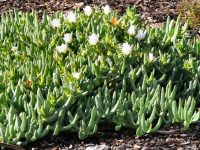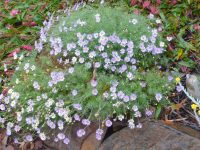The last few Australian summers have seen temperatures soar with devastating bush fires affecting so many parts of our continent. Sadly, it seems that extreme weather conditions are set to become more regular and last longer, so property and livelihoods will continue to be affected. I have understandably been asked regularly about whether or not it is possible to create an Australian native garden that is more likely to withstand the threat of bushfire compared to a garden that has not been planned with this in mind. It is important to say here that no garden can be guaranteed to survive or provide protection against some of the extreme fire storms that our country has been through, but with some careful planning, there are a number of things that can be done to help minimise risks somewhat. A garden and property that has been planned with bushfire in mind will generally have more of a chance than one where no thought has been given.
So, why am I talking about this when we are still in the midst of winter? Well, just like fit, healthy bodies take time to build, so does a thriving garden! If you start planning and planting now, then by summer time your plants will be much more established and will have a better chance of getting though the harsh conditions of summer.
My previous property was surrounded by bushland, so I did put some extra measures in place, such as roof sprinklers that were specially designed for fire prevention and threw water many metres around the house, a dedicated fire fighting water tank connected to independent fire fighting pumps and a nearby pond as an easily available water source. One of the most important things is to reduce the fuel load close to your house by removing anything flammable that does not need to be there. Of course, cleaning out your gutters and installing gutter guards are other obvious measures. I would urge people in higher risk areas to consider some of these extra practical moves where possible. Talking to your local fire authorities about your individual needs is also a great idea, especially well in advance of summer.
In addition to the previous measures, I also investigated the different flammability of a range of plants. Although no plant can ever be absolutely resistant to fire, and all could catch alight with enough heat and wind, there are some species that are much, much better than others. Plants in the Myrtaceae family ( for example, gum trees, Callistemon, Melaleuca, Leptospermum) have essential oil glands in their foliage, and while this fact gives them their distinctive smell and provide some very useful and medicinal oils, it also makes them far more flammable because of a lower ignition point than species with low oil content. Such species have apparently evolved over millions of years and have adapted to survive fire and potentially replace other species that are not so well adapted. So, avoid planting these species close to any structures you wish to protect, and particularly avoid trees and shrubs that might grow high enough top drop their flammable leaves onto your roof and gutters.
At the other end of the scale, succulents, by definition have much higher moisture content than the leaves of non-succulents and thus are known for their more fire-retardant capabilities compared to your average plant. There are some wonderful Australian native succulents, which I would love to see become more widely known and have the recognition they so deserve. Carpobrotus rossii and Disphyma crassifolium are wonderful examples of this, and I selected 3 to be garden winners, Carpobrotus White Hot, Carpobrotus Pink Passion and Disphyma Hot Stuff. Click on each to read more…..they also are good bush tucker plants.
These glorious Australian native succulents are living ground covers, and so are better than dry leaf litter or mulches, reducing the fire risk that can be created through falling embers. Other groundcovers with higher moisture content and lacking in flammable essential oils, such as Brachyscome, Goodenias, native violets are also useful if you don’t want the gravel or bare earth look. The key is to think about an ember attack that blows onto your property and removing flammable fuel and replacing it with something safer.
When planning a garden with fire safety in mind there are quite a number of other elements that can be considered. First of all, I recommend thinking about the positioning of certain things. For example, if you have plants near your house, make sure they are low growing. This will help avoid dead leaves and branches falling onto your roof and into gutters, which can create big issues during times of fire. You might also want to consider using an inorganic material such as gravel or scoria as topping for paths or as mulch in garden beds that are close to the house, rather than organic materials such as pine bark or eucalypt chips, which has the potential to ignite. You might also want to include a water feature such as a pond with the addition of water plants as an additional reservoir that fire brigades can tap into in an emergency, whilst providing a great addition to a wildlife friendly native garden.
I hope the above ideas have provided some good food for thought. For those wishing to learn more, I have a book called “The Australian Native Garden,” which has now been re-released as “The Waterwise Australian Native Garden.” The book has a whole chapter dedicated to this topic and can be purchased on the Gardening With Angus shop>>>
By coincidence, as I was writing this newsletter, another one from one of the informative study groups from the Australian Native Plants Society (Australia) landed in my inbox . This one was from the Garden Design Study Group edited by renowned Queensland landscape architect Lawrie Smith, and the theme was ‘Fire Risk And Garden Design’. Here are a few tips from it-
- Grey and Silver Plants – There are other qualities of grey plants of which we could take advantage apart from the artistic ones. Two in particular are their qualities as fire retarders and
as light reflectors at night. Saltbush plants in the family of Chenopodiaceae have a high salt content in their tissues and this is the reason why they have a fire suppressing capacity.
Several of the ornamental greys can be used for this purpose. Atriplex sp and
Rhagodia sp, the true saltbushes, make particularly fine firebreaks. - I think there’s no doubt that eucalypts, with their oil-rich leaves and heavy leaf and twig drop, are a recipe for disaster if growing too close to a house.
- When Sydney Wattle flowered indigenous people began burning off to minimise tree crown fires.
- Low growing fleshy groundcover species are useful in fire mitigation at lower levels
If you would like lots of great reading from the Garden Design Study Group, head to their newsletter archives where you will find great inspiration about designing Australian native gardens – http://anpsa.org.au/design/des-news.html


